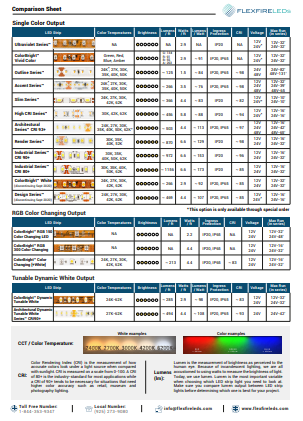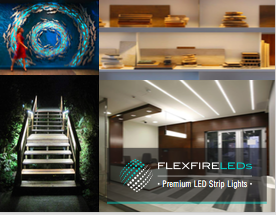Flexible LED Strip light buying guide: How to choose LED strip Lights
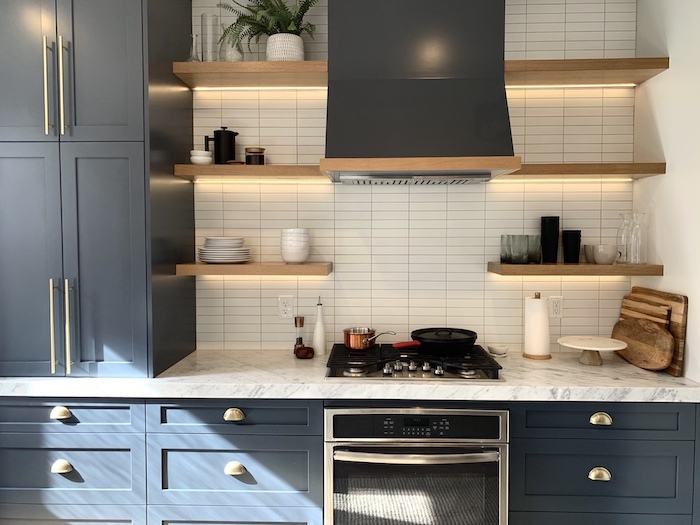
Accent cove lighting example with UltraBright Accent Series LED strip lighting
90% of customers found this information helpful before choosing their LED strip lights
The use of flexible LED strip lights is rapidly rising in modern lighting design around the world. Architects and lighting designers are implementing LED strip lights into residential, commercial, and industrial projects at an increasing rate. This is due to an increase in efficiency, color options, brightness, and ease of installation. A homeowner can now design like a lighting professional with a complete lighting kit and an hour or two.
There are many options on the market for LED strip lights (also called LED tape lights or LED ribbon lights) and there is no clear-cut standard for how to choose LED strip lights. We have created this guide to educate experts and newcomers alike.
New to LEDs?
What are LED strip lights and what can they do?
AI-powered Product Selector by Project
LED strip light customer-submitted project photos
LED strip Light Comparison Sheet
Flexfire LEDs Catalog with many photo examples
Important notes before getting your project started:
Step 1: Get a clear vision first!
Because each project is unique, there is no all-in-one solution. Different projects require different types of LED strips. Answer the questions below in your head before starting any project. We're here to walk through these with you as well.
Location
- What type of location are you in? Residential, commercial, retail, outdoors?
- What specifically will you be lighting?
- Where will it be installed? Under cabinets, kick boards, coves, eaves and awnings, backlighting, display cases, international space station?
- Will the lights be exposed to the elements or liquids?
- What material will the lighting be attached to?
- How many feet do you need?
Functions and aesthetic
- What overall look do you want to achieve?
- Do you want accent lighting, task lighting, perimeter lighting, indirect lighting, principal lighting, specialty application, etc
- What materials or objects am I lighting or using the strips for?
- Do I need High CRI for high color rendering? (See below for explanation)
- Do you want the lights to emit a white light only? Single color like red, green, or blue? Have the ability to change colors with a remote? Or have the ability to change the white output from warm to cool white with a remote?
- Are there other lights in the area and if so, what color are they?
- Do you want to dim your lights or control them with a remote or wall switch?
Emotions
- What are the non-physical results you want to achieve?
- Do you want to create a calm, seductive, energetic, hopeful, safe, relaxed, bold, or fun environment?
- What do you want your guests and customers to think or say when they enter your space?
Ready? Let's Go!
- Top 4 things you need to know before choosing or comparing LED strip lighting -
1. Compare Lumen, CCT, and CRI (Color Rendering Index)
1.1 Lumen (Brightness)
Lumen is the measurement of brightness as perceived to the human eye. Because of incandescent lighting, we are all accustomed to using watts to measure the brightness of light. Today, we use lumen. Lumen is the most important variable when choosing which LED strip light you need to look at. When comparing lumen output from strip to strip, note that there are different ways of saying the same thing.
The questions you should be asking is “Lumens per what? Per foot, meter, or reel? How long is the reel?”
Different projects require a certain amount of brightness to achieve a desired look. Our advice is to always go brighter than needed and add a dimmer. Running your LEDs below their full power and brightness can also increase lifespan.
Below is a general guide. We are always available to help design your project with you.
Quick Guide of needed lumens by project type:
Accent Lighting and Mood Lighting - 100 to 350 lumens per foot
Under cabinet Lighting - 175 to 525 lumens per foot
Task Lighting with low distance from light source - 280 to 437 lumens per foot
Task Lighting with higher distance from light source - 500 to 1000 lumens per foot
Indirect lighting in a bedroom/ hotel / vehicle / lobby - 375 to 562 lumens per foot
Industrial lighting / signage / tube replacements - 500 to 950 lumens per foot
Here is an example of our White Output LED Strip Lights and the lumen they emit:
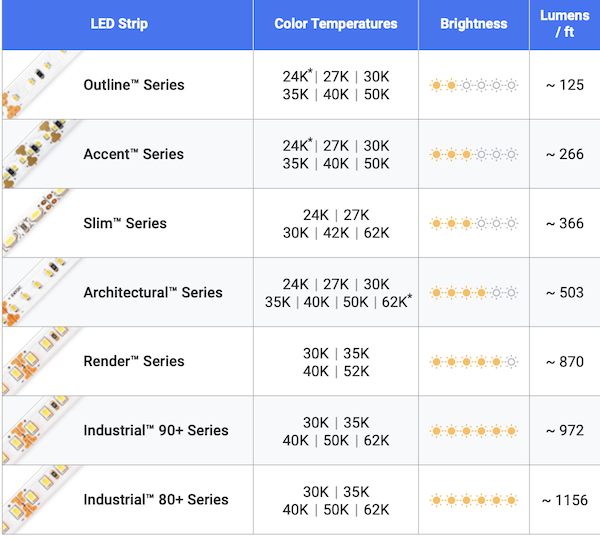
Important: Be careful if the company does not state the lumen output. You will have no idea what the brightness will be until you purchase them. Flexfire LEDs has some of the brightest LED strip lights in the world. If quality is important to you, always request the test data sheets from any company to verify their claims of "lumen output".
Using Lumen as the only comparison can be tricky! Some brands over-power their LEDs to make them brighter. Sadly, this will make them fail faster and burn up. We under power our LED chips to make sure they last longer than rated.
1.2 CCT - Color Temperature
CCT (Correlated Color Temperature) refers to the color temperature of light, measured in degrees Kelvin (K). The temperature rating directly affects what the white light will look like; it ranges from cool white to warm white. For instance, a light source that has a 2000 – 3000 K rating is seen as, what we call, warm white light. Warm white light looks very orange and/or yellow. When increasing the degrees Kelvin, the color will change from yellow to yellowish white to white and then a bluish white (which is the coolest white). Although the varying temperatures have different names, it should not be confused with actual colors such as red, green, or purple. CCT is specific to white light or rather, the color temperature.

"Can I order a 6000k light from amazon and a 6000k light from you and they will look the same?" The answer is quite possibly no.
All CCTs are not created equal. You may notice that some lights that are "cool white" may not look pure white. They may give off a greenish, purplish, or bluish hue to them. This is because the LEDs have been selected from a presorted pile (bin) that is far from true white, in order to save money. It is important to ask the manufacturer of the LED strips how they BIN their LEDs and what their selection process is. Our strips are always selected from the same bin, to make sure every batch is the same and there are no color differences.
Which color temperature should you choose?
Here is an example of the same bedroom under 2700k, 3500k, 4200k, and 6200k lights. Notice how lighting changes the mood and style of the space! The aesthetic, function, or emotion of a space may change depending on the color temperature you use. Choosing the right color temperature is not difficult, but make sure you take into consideration the colors of your walls, the floor, what you will be illuminating, what activities will be completed in the area, or if there are local regulations telling you what CCT to use (Like California's Title 24).
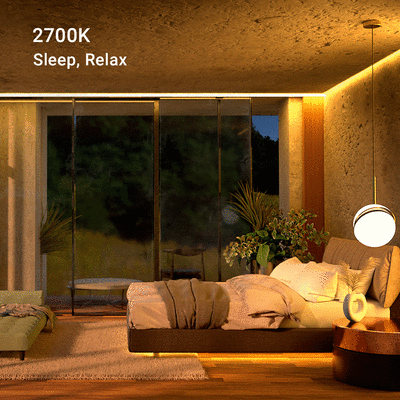
If you are having difficulties choosing which LED CCT is best for your project, consider purchasing a Tunable White Strip.
- Dynamic Tunable White LEDs allow you to choose which CCT from 2700k - 5000K with a remote control
- Dim-to-Warm LEDs allows the LED strip to change from 3000K to candlelight 1800K as you dim it
1.3 CRI - Color Rendering Index
Article: What is CRI? CRI Explained
Can’t tell the difference between the black and navy colored socks in your walk in closet? Could be that your current lighting source has a very low CRI!
Color rendering index (CRI) measures how colors are correctly rendered under a light source in comparison to natural sunlight. The index is measured on a 0-100 scale with 100 being a perfect rating of color accuracy, meaning the colors appear as they naturally would under unadulterated daylight. High CRI lighting is sought out everywhere, but is particularly valuable in. The bottom line: the higher the CRI, the higher quality is the light source.This rating is also a measurement in the lighting industry to help discern naturalness, hue discrimination, vividness, preference, color naming accuracy, and color harmony.
95 - 100 CRI → Phenomenal color rendering. Colors appear as they should, subtle tones pop out and are accented, skin tones look beautiful, art comes alive, backsplashes and paint shows it's true beautiful full saturation. You have to see it to believe it! Our Outline series, Render Series, and Accent Series have CRIs up to 98!
90 - 95 CRI → Great color rendering! Almost all colors 'pop' and are easily distinguishable. Noticeably great lighting starts at a CRI of 90.
80 - 90 CRI → Good color rendering, where most colors are rendered well. You may not see items as fully saturated as you would like, but most people will not notice.
60 - 75 CRI → Poor color rendering. Items and colors may look desaturated, drab, and at times unidentifiable (cannot see the difference between black and navy colored socks).
See our High CRI LED Strip Lights
2. Compare LED strip size and number of LEDs on the strip
Traditionally, LED strip lights are packaged on a reel (spool) of 5 meters, or 16' 5''. The machines used to "pick and place" the LEDs and resistors on the flexible circuit board are typically 3' 2'' in length, so individual sections are soldered together to complete a whole reel. If purchasing, make sure you are purchasing by the foot or by the reel. Confirm length before checking out.
Measure how many feet you need of LED strips before you start. This will make it easier to compare price (after quality is compared, of course). Once you determine the number of feet on the reel being sold, look at how many LED chips are on the reel and the LED chip type. This can be used to compare LED strips between companies.
What do the numbers of the LED chips mean?
The numbers referenced before the LED type specifically detail the size of the LED.
Below is an example of what the numbers mean when companies talk about LED strip lights. Here is a full writeup on What is the difference between 5050 and 3528 and 3014 LED chips?
Not all chips are created equal either, you can purchase a 2835 LED strip from Amazon and one from a high quality manufacturer, and all the components, CRI, light quality and longevity can be different. These numbers specifically detail the size of the LEDs.
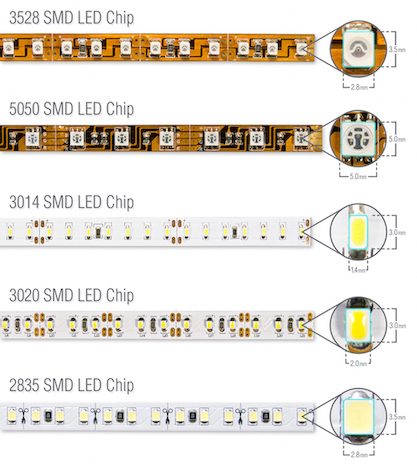
Types of LED chips and meaning of their indicated numbers
3. Wattage consumed per strip of LEDs
Power consumption is one of the reasons we as a society have begun switching to LEDs. Wattage tells us how much power we are consuming while these lights are on, and in turn how much we’ll have to pay at the end of each month. Once again, be sure to verify the wattage per foot, meter, or reel before you buy.
Some may read “24 watts” on a reel and then get home and realize this is per meter or per foot, meaning the whole reel actually uses much more. Making matters worse, they have bought a power supply that covers 30 watts, thinking that would be enough. This often occurs when a seller doesn’t properly list important information in an easy to read format.
Finally, make sure you understand the voltage that your flexible LED strip lights use. An LED strip light that uses 24 volts will not work if you purchase a 12-volt power supply, and also may result in risk of fire. You need to choose the correct power unit for your lights.
4. Verifiable Quality
You are looking for a "set-and-forget" lighting system that can be used for years to come. To make sure that your LEDs last their intended lifespan, are safe around your home and business, and don't require extra maintenance costs to replace, you need to verify the quality claims.
1. Thermal Management - Heat = death to LEDs. Ask if and how the LED strip lights have been designed for proper thermal management and heat dissipation. If they have not, the LED's 50,000+ hour LED chip lifespan may drop to 10,000 or 20,000 hours. This can be done on a chip level and on a PCB level. Do not solely rely on an aluminum heat sink to dissipate heat away from the LEDs. The product should be designed at a component level to ensure a longer lifespan.
2. Color Quality and Accuracy - When you purchase a '3000K warm white' LED strip light you should not expect to get a bright white color from the LEDs. Ask for test reports that prove the color you are purchasing is what will arrive. This is especially important when adding additional lighting to an existing installation. If the colors do not match it will be very noticeable.
3. Safety Certifications - It is difficult to verify a seller’s safety claims using Amazon or Ebay alone. Check the UL listing, REACH, or RoHS registry to make sure the LEDs are safe and do not contain lead or other hazardous materials.
4. Material Quality - Product performance and longevity is determined not just by the quality of the LEDs, but the thickness and materials used in the PCB, resistors, wires, and lead-free soldering.
5. Test Reports - Ask for test reports to verify claims of brightness and longevity. These may include LM-79 testing, IES reports, etc.
6. Warranty, Customer Service, and Installation/Design Assistance - We are here to help design your project, no matter what the size. Our LED strip lights represent the highest quality found on the market today, and will be lighting your project area for many years to come. We also boast the longest warranty of any LED strip light in the market of 15 years!
Which LED strip should I choose?
White Output
Outline Series™- For long runs of light. Subtle, beautiful accent lighting with near perfect color rendering. CRI up to 98.
Accent Series™- For the perfect ambiance. Bright accent lighting suitable for most residential, hospitality, and retail spaces. CRI up to 98.
Architectural Series™- Double the brightness of the Accent Series. Perfect for high-brightness applications like coves, architecture, and retail. CRI93+
Industrial Series™ - Packs a serious punch. Extremely bright for where a lot of light is needed. CRI up to 96.
Slim Series™ - Thinnest LED strip light for specialty applications with a width of only 3.5mm
Dynamic Tunable White Output
Accent Series™ Dynamic Tunable White - Mid-range Brightness adjustable from 2700K - 6200K Small cut lengths, long run length, high CRI of 98
Architectural Series™ Dynamic Tunable White - High Brightness adjustable from 2700k - 6200K, high CRI of 94
Sienna™ Series Dim-to-Warm Tunable White - As the lights dim, they automatically warm from 3000K to 1800K. Used with any dimmer and have a high CRI of 94.
RGB Color Changing Output
ColorBright™ RGB 150 Series - Lower brightness for accent lighting, long run length. 150 LEDs per 16ft spool. Low power consumption at 2.2w/ft
ColorBright™ RGB 300 Series - Mid brightness for task and accent lighting, 300 LEDs per 16ft spool. Low power consumption at 4.4w/ft
ColorBright™ RGB 600 Series - Very high output to fill your space with gorgeous color, 600 LEDs per 16ft spool. Medium power consumption at 6.1w/ft
ColorBright™ RGB+White Series - Choose any color as well as a pure white. 50% RGB LEDs and 50% White LEDs.
ColorBright™ RGB+Tunable White Series - Best of all worlds. This 5-in-1 strip boasts full RGB color control and full spectrum Tunable White technology CCT range: 2400K-6500K. High CRI and emits over 260lm/ft
ColorBright™ Digital Pixel Series - WS2811 IC Protocol 'digital strips' mean each segment is individually controllable. Create scrolling effects.
Other considerations when choosing your LED strip lights:
You need a product you can trust and will produce a good clean light for years to come and save you money in the process.
The LED market is highly saturated with manufacturers and distributors offering various levels of quality, cost, and specifications. Due to safety and quality purposes, we have created this page and video to ask the question of what the difference is between Flexfire LEDs and other competitors like the ones on Amazon - LED Strip Light Reviews - Flexfire Vs Amazon Strip
Flexfire LEDs' strip lights have been used by NASA, Lockheed Martin, JPL, US airports, Disney, Hilton Hotels, major retail chains, and thousands of happy homeowners. Chances are you've seen our lights somewhere.
Save this comparison chart and compare with other LED strip lights:
Download the Strip Light Comparison Chart
View our catalogs for design ideas:
Flexfire LEDs Catalog / Brochure
Need help with your project or selecting the perfect lights?
We have LED project design specialists ready to help educate and assist you in your project.
Please contact us or call us at 1-844-353-9347 OR 1-925-273-9080


